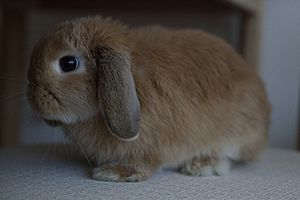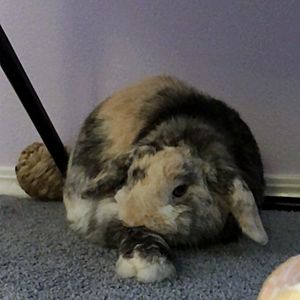Mini Lop facts for kids
The Mini Lop is a popular type of domestic rabbit in the United States. It is recognized by the American Rabbit Breeders Association (ARBA). It is important not to confuse the Mini Lop with the Miniature Lop from the United Kingdom, which is recognized by the British Rabbit Council (BRC). Even though they have similar names, they are different breeds! The Mini Lop is also different from the Dwarf Lop breed. Mini Lops are similar to other small rabbit breeds, like the Dwarf rabbit.
Contents
History of the Mini Lop Rabbit
The Mini Lop breed was first discovered in Essen, Germany, in 1972. A person named Bob Herschbach saw these rabbits at a German National Rabbit Show. At that time, they were called Klein Widder.
These early Mini Lops came from two other rabbit breeds: the German Big Lop and the small Chinchilla. The first Mini Lops were usually agouti (a common wild rabbit color) or white.
German Lops were quite large, weighing about 8 pounds (3.6 kg). They were slender with thick ears. Bob Herschbach wanted to bring these rabbits to the United States. In 1972, he successfully bred Mini Lops in the US. He started with an agouti lop pair and a white female lop. Their first baby rabbits were solid colors. Later, a second group of babies had "broken" colors, meaning they had patches of color and white. Through careful breeding, they started to get Mini Lops with very good qualities.
In 1974, Bob Herschbach showed his Mini Lop rabbits for the first time at an American Rabbit Breeders' Association (ARBA) meeting. This meeting was in Ventura, California. People at the meeting thought the breed needed to be smaller and more attractive. To make the rabbits smaller, Herschbach asked other breeders to help. He let them breed more of his Mini Lops. They also decided to change the breed's name from Klein Widders to "Mini Lop." This new name sounded more appealing to people.
In 1977, a new person, Herb Dyke, took over promoting the Mini Lop breed.
In 1978, Herschbach and Dyke started a club for Mini Lops. In just one year, over 500 members joined! They all contacted ARBA to show their support for the Mini Lop rabbit.
Finally, in 1980, the Mini Lop breed became official! At the National Rabbit Convention in Milwaukee, Wisconsin, ARBA recognized it as an official rabbit breed. Soon after, the Mini Lop Club of America was created to help promote this wonderful rabbit.
Mini Lop Rabbit Personality
Just like people, every Mini Lop has its own unique personality. However, they are generally very friendly and love to play! Like all rabbits, Mini Lops can learn many tricks and commands. You can even train them using a clicker. When you click the clicker and give them a treat, they learn to come when they hear the click.
Mini Lops have a special way of showing they are upset: they stamp their hind foot. This might happen if you are late with their food or snacks. They also might stamp their foot if they feel a stranger is in their space. It's their way of showing who's boss!
Even though they are playful and energetic, Mini Lops usually do best in quiet homes. They are often more comfortable with older children. This is because they can be a bit shy or easily scared. Mini Lops need lots of time outside their cage to run around. They also need plenty of toys and activities to keep them busy.
Showing Mini Lops in Competitions
When judges look at a Mini Lop in a show, they want to see a rabbit that looks like a "basketball with a head." This means they look for a nice round body that is thick and deep. They also want to see long, thick ears, a wide head, and strong bones.
ARBA Accepted Colors for Mini Lops
When you show Mini Lops, their colors are divided into two main groups: Solids and Brokens. While there are many beautiful colors for this breed, only certain ones are allowed in shows. Some of these accepted colors include:
- Chinchilla
- Chestnut Agouti
- Lynx
- Opal
- Black
- White
- Ruby-Eyed White (REWs)
- Blue-Eyed White (BEWs)
- Blue
- Chocolate
- Lilac
- Orange
- Tri Color
Mini Lop Standard of Perfection
The ARBA has a "Standard of Perfection" that judges use to score Mini Lops. Here's how the points are given:
- General Type: 80 points (This includes the overall body shape, head, ears, and legs.)
- Body: 43 points
- Head: 20 points
- Ears and Crown: 12 points
- Feet, Legs & Bone: 5 points
- Fur: 10 points
- Color & Markings: 5 points
- Condition: 5 points
Weight Limits for Showing Mini Lops
Mini Lops are considered a medium-sized rabbit breed.
- Senior Bucks (males 6 months or older): Should weigh between 4.5 to 6.5 pounds (2 to 3 kg).
- Senior Does (females 6 months or older): Should weigh between 3 to 6 pounds (1.4 to 2.7 kg).
- Junior Bucks and Does (under 6 months): Should weigh between 3 to 6 pounds (1.4 to 2.7 kg).
The perfect weight for a senior Mini Lop is about 5.5 pounds (2.5 kg).
What Judges Look For in a Mini Lop
Body Shape
A Mini Lop should look strong and heavily muscled. It should have a good balance of width and depth, being a bit wider at the back (hindquarters) and tapering towards the shoulders. The back should have a nice curve, rising over the spine and peaking over the hips. The hips should be smooth, deep, and well-rounded.
- Things to avoid: A long, narrow body, hips that look "chopped off," or flat shoulders.
Head Shape
The Mini Lop's head should look strong and bold. It should sit very close to the shoulders, with almost no neck visible. The top of the head should be strongly arched. The head should look wide, with a full muzzle. The head's size should match the body. Male rabbits (bucks) usually have wider heads than females (does).
- Things to avoid: A long, narrow head, a pointy nose, or a flat top of the head.
Ears
The ears are very important for a Mini Lop. They should start from a strong base and then hang vertically down both sides of the head, looking like a horseshoe. The ears should lie close to the cheeks, with the ear openings facing the head. The ears should be about .75 to 1 inch (2 to 3 cm) below the jaw and match the rabbit's size. They should be well-furred and rounded at the ends.
- Things to avoid: Ears that don't hang correctly, folds in the ears, very thin or thick ears, or ears that turn away from the head.
Legs and Feet
The legs are important for the rabbit's overall look. They should be straight, short, and thick. For "broken" colored rabbits (with patches of color and white), the toenails can be light or dark. The front and back nails can be different colors, but all front nails must match each other, and all back nails must match each other.
- Things to avoid: Toenails that don't match in "broken" colored rabbits.
Fur
The Mini Lop's fur should be very thick and dense. It should look shiny and healthy. The fur is medium in length and should "roll back" smoothly when you stroke it.
- Things to avoid: Long, thin, silky, harsh, or very short fur.
Color and Markings
Mini Lops come in many beautiful colors. When choosing a rabbit, the overall body type is more important than the color. In judging, points for color are split between the color itself and any markings.
- Broken Pattern: This includes any recognized color mixed with white. Judges prefer a "butterfly" marking on the nose (a colored shape with white outlines), colored circles around the eyes, and both ears colored. The body should have a large colored patch or several patches. The front feet should be white, and the back feet can also be white.
- Solid Pattern: This includes any single recognized color.
- Things to avoid: Missing head markings, light body markings, or too many white hairs in a solid-colored rabbit.
Eyes
The eyes can be any color, but both eyes must match each other.
- Things to avoid: Eyes that do not match. Also, for solid-colored rabbits, any spots of a different color in the eyes are not allowed.
See also
 In Spanish: Mini Lop para niños
In Spanish: Mini Lop para niños



